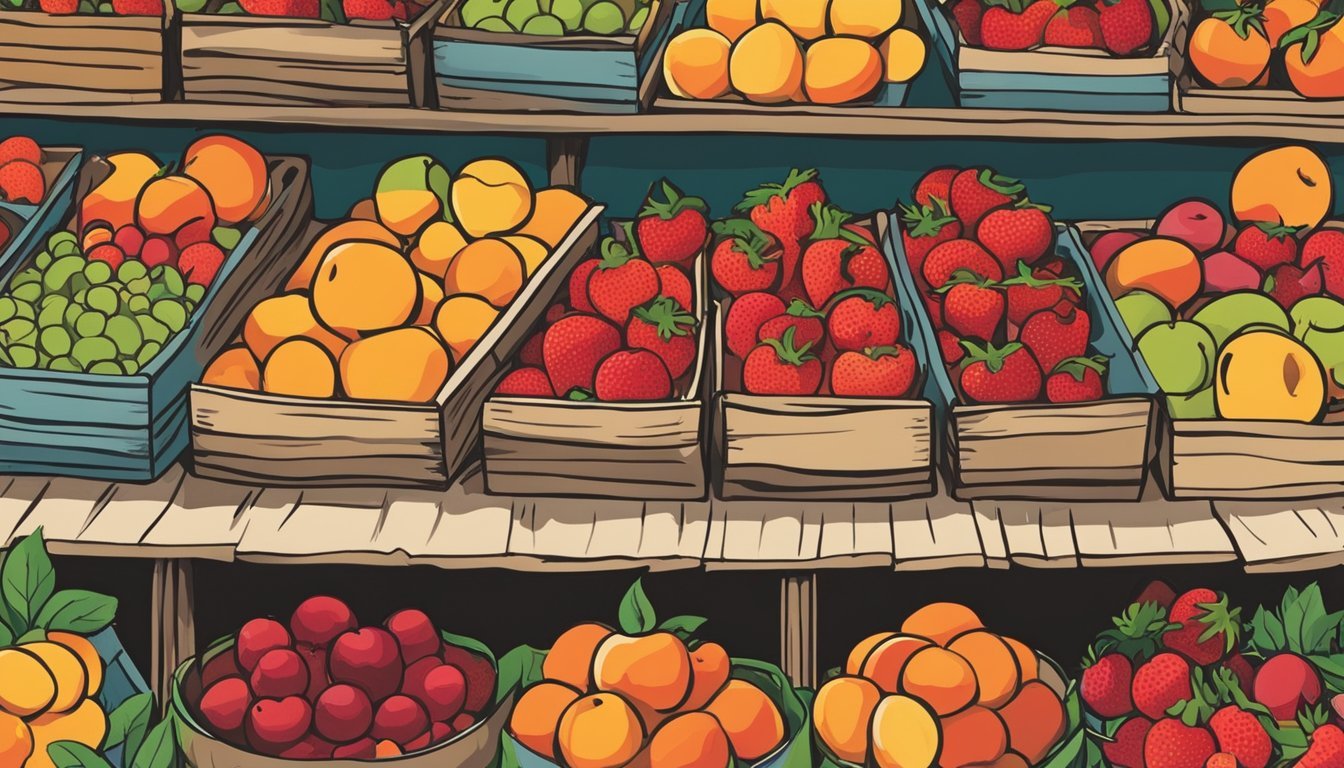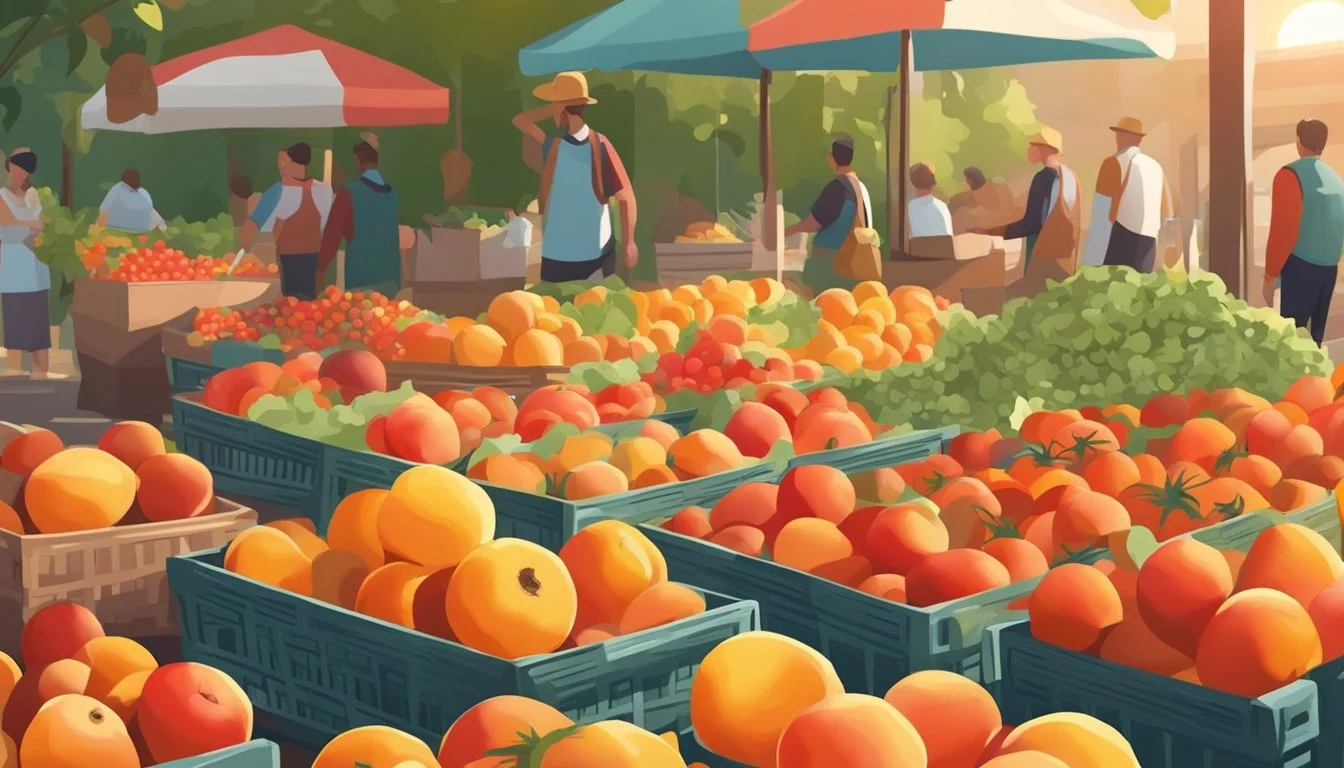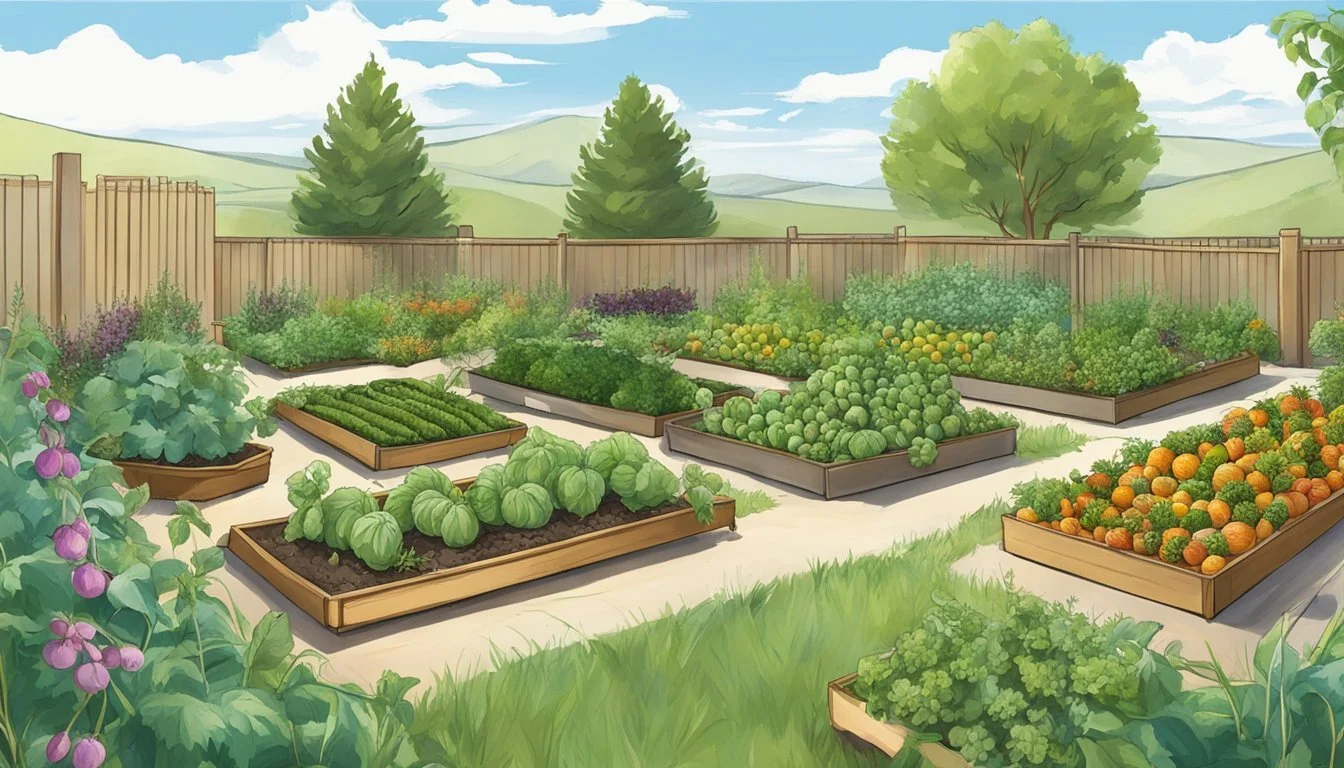Wyoming Seasonal Fruit & Vegetables in July
Your Fresh Guide
This Article is Part of our Wyoming Seasonal Fruit & Veg Calendar
July in Wyoming offers a diverse palette of fresh fruits and vegetables, as the summer's warmth brings a variety of produce to perfect ripeness. This midsummer month is the prime time for local farmers and gardeners to harvest the bountiful yields that the state's rich soil and favorable growing conditions have nurtured. Across Wyoming, farmers' markets and roadside stands become vibrant with the colors and aromas of the season's best.
The agricultural scenery is framed by a transition from early summer harvests to the peak of mid-summer productivity. Wyoming’s July harvest includes a range of fruits and vegetables, from the luscious sweetness of berries to the earthy richness of root vegetables. Residents and visitors alike look forward to the freshness and quality that come with produce harvested at its seasonal peak, offering a true taste of Wyoming's local flavors.
Gardening enthusiasts and commercial growers in regions that cover USDA hardiness zones 4 through 6 find this month particularly rewarding. The state's climate, characterized by warm days and cool nights, supports the growth of a variety of crops that reach their prime in July. This cyclical bounty not only sustains local communities but also invites them to celebrate the season with events centered around agriculture and fresh food.
Overview of Wyoming's Growing Season
The state of Wyoming boasts a dynamic growing season defined by its varied climate, which significantly influences the agricultural practices and seasonal eating habits.
Climate and Agriculture in Wyoming
Wyoming's climate is predominantly semi-arid and continental, which affects what and when fruits and vegetables can be cultivated. The state's gardening zones, per the United States Department of Agriculture (USDA), generally range from 4 through 6. This presents a challenge to growers, as the growing season can be short, with harsh winters and variable weather. Despite these challenges, July marks a period of abundance.
Key Growing Seasons
Spring to fall in Wyoming signals the active growing seasons. Fruits and vegetables have distinct planting and harvesting times:
Spring (April to June): Primarily for planting cool-season vegetables.
Summer (July to September): Pinnacle of Wyoming's fruit and veg availability, exemplified by July's bountiful harvests.
Fall (October to November): Late-season crops are harvested, and preparations for winter begin.
Winter (December to March): Primarily dormant; some hardy crops and storage of harvests.
In July, gardeners and farmers harvest summer crops and enjoy a plethora of fresh produce including:
Fruits: Raspberries, strawberries, and possibly early varieties of apples.
Vegetables: Bell peppers (What wine goes well with bell peppers?), cucumbers, tomatoes, summer squash, and leafy greens.
Importance of Seasonal Eating
Seasonal eating in Wyoming is not just a preference—it's often a necessity due to climate restrictions on year-round availability. Taking advantage of the fresh produce in July aligns with environmentally sustainable practices and supports the local economy. Eating seasonally ensures that residents consume fruit and vegetables at the peak of their freshness and nutritional value.
By understanding Wyoming's unique growing season, particularly the valuable summer months, residents can maximize their gardens' yield and contribute to a community that values fresh, local produce. July showcases the state's agricultural potential with a variety of fruits and vegetables that are not only fresh but also integral to the local cuisine and culture.
Seasonal Fruit in Wyoming for July
In July, Wyoming's agricultural bounty offers a peak in freshness and flavor for a variety of fruits. Residents and visitors alike can indulge in the refreshing taste of seasonal berries, stone fruits, and melons, each at their maximum ripeness.
Berries
Blackberries: Abundant in July, these berries are known for their deep flavor and can be found at their ripest.
Raspberries: A delicate fruit, raspberries are also in high season, offering a slightly tart but sweet experience.
Blueberries: Cherished for their antioxidants, blueberries are typically in full production during this month.
Strawberries: Although their season starts earlier, there may still be some late strawberries available, perfect for a sweet snack.
Stone Fruits
Cherries (how long do cherries last?): Harvested in early to mid-July, cherries in Wyoming are juicy and perfect for eating fresh or baking.
Peaches and Nectarines: Both of these similar fruits come into season in July, providing a succulent and aromatic addition to Wyoming's fruit offerings.
Plums: With a diverse range of varieties, plums bring a sweet and sometimes tart option to the summer fruit landscape.
Melons
Watermelon: A classic summer refreshment, watermelons are at their best in July, offering crisp and hydrating slices.
Cantaloupe (how long does cantaloupe last?): Also known as muskmelon, cantaloupes thrive in the warmer July temperatures, delivering a sweet, musky flavor that's hard to resist.
Seasonal Vegetables in Wyoming for July
July in Wyoming marks the height of summer, a peak time for a variety of vegetables thriving in the warm weather. Gardens and farms across the state bring forth an abundance of fresh produce, offering a bounty of flavors and nutrients.
Leafy Greens
Wyoming's July gardens are still home to a range of leafy greens. Despite the warmer temperatures, one can find kale, spinach, and lettuce, which remain staples in salads and summer dishes. These greens should be harvested regularly to encourage new growth and avoid bitterness that can come with the summer heat.
Kale: A versatile green, rich in vitamins.
Spinach: Tender and packed with iron.
Lettuce: Crisp and refreshing, ideal for salads.
Summer Squashes
Summer squashes are in their prime during July. Gardeners can enjoy a profusion of zucchini and yellow squash, which are known for their rapid growth and high yield during this time of the season.
Zucchini: Perfect for grilling, sautéing, or baking.
Yellow Squash: Mild in flavor, suitable for a variety of dishes.
Root Vegetables
As July unfolds, root vegetables like carrots, beets (how long do beets last?), and radishes can be unearthed to reveal their vibrant colors and earthy flavors. These vegetables appreciate the cooler soils and can be enjoyed both raw and cooked.
Carrots: Sweet and crunchy, excellent raw or roasted.
Beets: Deeply pigmented, with a sweet and earthy taste.
Radishes: Peppery and crisp, adding a kick to salads.
The variety of vegetables available in July in Wyoming embodies the abundance of the summer season, with each offering unique flavors and health benefits.
Selecting and Storing Produce
Proper selection and storage of fruit and vegetables are crucial for maintaining their flavor and freshness. In July, a variety of produce reaches its peak in Wyoming, and knowing how to handle and store these items will ensure the best taste and longevity.
Handling Delicate Berries
Berries such as blackberries and blueberries are in season and demand careful handling to prevent bruising. One should gently rinse them in cold water and pat dry before storage. For optimal freshness, store them in a single layer in a moisture-proof container in the refrigerator.
Storing Stone Fruits
Stone fruits like cherries and apricots thrive in July's warmth. To preserve their flavor, store unripe stone fruits on the counter at room temperature, away from sunlight. Once ripe, they can be moved to the fridge where they should be kept in a plastic bag with holes for circulation.
Keeping Greens Fresh
Leafy greens, abundant in summer, require a humid and cool environment. Wrap unwashed greens loosely in a damp paper towel and place them in a sealed container or plastic bag. This method helps maintain moisture and keeps the greens crisp.
Root Vegetable Storage
Root vegetables such as beets and carrots should be stored in a cool, dark, and well-ventilated place, ideal conditions for prolonging their shelf life. It's best to remove any tops to prevent moisture loss and store them in the crisper drawer of the fridge.
Preparing and Cooking
July in Wyoming offers an abundant variety of fresh produce, providing ample opportunities for creativity in the kitchen. From vibrant salads featuring leafy greens and crisp cucumbers to sweet desserts brimming with berries, the focus is on making the most of summer's harvest.
Summer Salads and Dressings
Wyoming's July yields a spectrum of fresh vegetables perfect for summer salads. Ingredients like tomatoes, cucumbers, radishes, spinach, lettuce, and carrots can be combined to create refreshing dishes. One can toss these ingredients in a homemade vinaigrette using local herbs for a burst of flavor. An example dressing might include:
3 parts oil (like olive or avocado)
1 part acid (like vinegar or lemon juice)
Salt and pepper to taste
Herbs such as dill or basil
Grilling and Roasting Vegetables
Hearty vegetables like beets, carrots, and summer squash are excellent when grilled or roasted. This brings out their natural sweetness and adds a smoky depth of flavor.
Beets: Wrap in foil with a drizzle of oil and roast until tender.
Eggplant: Slice and brush with oil, then grill for a charred exterior.
Summer squash and peppers: Toss in olive oil, salt, and pepper; grill for quick, smoky sides.
Desserts with Seasonal Fruit
Sweet, juicy berries and watermelon found in Wyoming during July make for perfect dessert ingredients. Berries can be used in compotes, served over ice cream, or baked into pies. Watermelon serves as a refreshing end to any meal, or it can be incorporated into cocktails or sorbets.
Berry Compote: Simmer berries with a touch of sugar and lemon until they break down into a sauce.
Watermelon: Cube and chill for a simple treat, or blend into a smooth puree for sorbet.
Health Benefits and Nutritional Information
In the midst of July, Wyoming's seasonal fruits and vegetables offer an abundance of health benefits and nutritional richness. These foods are integral to a balanced diet and are packed with essential vitamins and antioxidants that promote overall wellness.
Fruits in Season:
Berries: They are rich in antioxidants and vitamin C, which support immune function and skin health.
Stone Fruits: Peaches and cherries are high in vitamin A and potassium, aiding in heart health and vision.
Vegetables in Season:
Leafy Greens: Varieties such as spinach and kale are celebrated for their high nutrient density. They are excellent sources of vitamins A, C, and K, as well as iron and calcium.
Bell Peppers: Available in abundance, these crisp vegetables are excellent sources of vitamins A, E, and C.
Nutrient Benefits Found In Vitamin A Supports vision and immune system Stone fruits, bell peppers Vitamin C Promotes healing and helps absorb iron Berries, bell peppers, leafy greens Vitamin E Acts as an antioxidant and supports skin health Bell peppers Vitamin K Crucial for blood clotting and bone health Leafy greens Antioxidants Protect cells from damage Berries, dark green vegetables
Consuming these seasonal delights not only offers a burst of flavor but also contributes to a healthier lifestyle. The freshness of produce picked at its peak ensures maximum nutrient retention and taste. The natural compounds found in these fruits and vegetables are beneficial in reducing inflammation and cleansing the body's systems, particularly notable in dark green, leafy vegetables that support liver health. By incorporating these seasonal foods into one’s diet, they can enjoy a colorful palate of health benefits.
Gardening Tips for Wyoming Residents
In Wyoming, the unique regional climate demands specific gardening approaches to ensure a bountiful harvest. July presents an opportune time to cultivate both fruits and vegetables, but successful growth requires adherence to certain practices that cater to the area's soil conditions and weather patterns.
Best Practices for Fruit Gardens
Climate Awareness: Gardeners should recognize the effects of Wyoming's typically cooler summer nights. Selecting cold hardy varieties of fruit trees, like the Golden Delicious and Granny Smith apple trees, can lead to successful cultivation even when unexpected frosts occur.
Pest and Disease Management: Frequent inspection of fruit gardens for pests and diseases is essential. Organic pesticides or integrated pest management can help maintain a healthy fruit garden while adhering to eco-friendly practices.
Optimal Vegetables for Wyoming Soil
Beans and Greens: Vegetables like beans and various greens thrive in Wyoming's July soil. They are less prone to the pests and diseases that could affect other crops during summer. Bush beans and pole beans are excellent choices as they require minimal space and yield a substantial crop.
Utilizing Compost: Amending the soil with well-rotted compost can enhance its nutrient content, benefiting vegetables such as lettuce and herbs which require rich, well-drained soils. These vegetables, along with others suited for the region, will prosper when provided with these improved soil conditions.
Pest Management and Disease Control
In Wyoming, July is a critical month for gardeners to monitor and manage pests and diseases in their fruit and vegetable crops. They encounter a variety of challenges that can affect the health and yield of their produce.
Pests: Gardeners should regularly inspect their plants for signs of pest infestation. Common culprits include aphids, spider mites, and the Colorado potato beetle. To manage these pests, they can employ a combination of manual removal, such as picking off beetles by hand, and the application of insecticidal soaps or neem oil as organic control methods. For severe infestations, specific pesticides may be required, always following the manufacturer's guidelines.
Diseases: Fungal diseases, like powdery mildew and blight, can thrive in the warm, sometimes humid conditions of July. Fruit trees and vegetable plants should be inspected for the white, powdery spots symptomatic of mildew, or the dark, soggy spots indicative of blight. Fungicides, either organic or synthetic, may be applied as a preventive measure or treatment. Good practices also include removing diseased leaves or plants to prevent the spread.
Preventive care is essential. A well-planned garden with ample spacing between plants ensures proper air circulation, which reduces the risk of disease. Mulching and adequate watering, avoiding plant foliage, can further diminish the potential for pest and disease issues.
Action Target Method Insect Monitoring Aphids, Beetles Visual checks, Sticky traps Disease Inspection Mildew, Blight Regular plant examination Pest Control Spider Mites Insecticidal soaps, Neem oil Disease Management Fungal Diseases Removal, Fungicide application
By staying vigilant and employing effective pest and disease control strategies, Wyoming gardeners can help ensure a successful harvest of fruits and vegetables in July.








